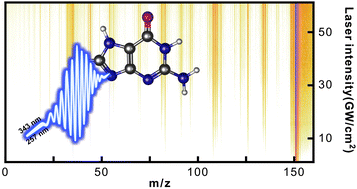High-throughput UV-photofragmentation studies of thymine and guanine†
Abstract
High-throughput photofragmentation studies of thymine and guanine were performed at 257 and 343 nm and for a wide range of ionisation laser intensities. Combining a continuous laser-based thermal desorption source with femtosecond multiphoton ionisation using a 50 kHz repetition rate laser allowed us to produce detailed 2D maps of fragmentation as a function of incident laser intensity. The fragmentation was distinctly soft, the parent ions being at least an order of magnitude more abundant than fragment ions. For thymine there was a single dominant fragmentation channel, which involves consecutive HNCO and CO losses. In contrast, for guanine there were several competing ones, the most probable channel corresponding to CH2N2 loss through opening of the pyrimidine ring. The dependence of parent ion abundance on the ionisation laser intensity showed that at 257 nm the ionisation of thymine is a 1 + 1 resonance enhanced process through its open-shell singlet state.



 Please wait while we load your content...
Please wait while we load your content...